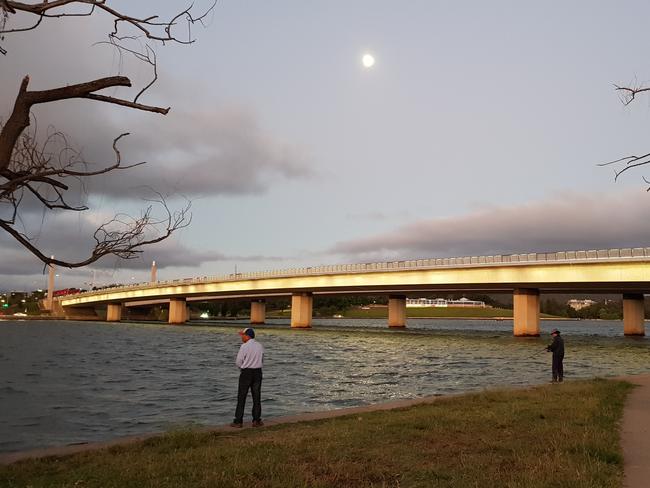ACT Heritage Council chair David Flannery canvasses options for future of Commonwealth Avenue Bridge
ACT Heritage Council chair David Flannery delves into the history of Commonwealth Avenue Bridge and shares his opinion on whether it should be knocked down to make way for light rail stage 2
To knock it down or not to knock it down?
This is the question which ACT Heritage Council chair David Flannery sets out to answer while exploring options for the future of the Commonwealth Avenue Bridge.
Mr Flannery is also a Research Fellow at Canberra Urban and Regional Futures at the University of Canberra.
Here is his unedited opinion piece:
Commonwealth Avenue Bridge, which crosses Canberra’s Lake Burley Griffin, was officially opened to traffic in November 1963. The current Kings Avenue Bridge predates the Commonwealth Avenue Bridge; it was formally opened by Prime Minister Robert Menzies on 10 March 1962. Both bridges are of concrete construction and replaced earlier timber structures. Although Scrivener Dam was completed in September 1963, the lake did not fill until joyous drought-breaking rains soaked the city in late April 1964.

Commonwealth Avenue Bridge is effectively two bridges with six lanes of traffic, three in each direction on dual bridge structures, with a cantilevered footpath (now a shared cycle path) on the outer side of each structure. The end spans of the bridge were designed to allow for the transit of traffic underneath on foreshore roads; and, like the earlier Kings Avenue Bridge, a clear space of 44 feet (13.4 metres) was left between the two bridge structures to provide adequate space for future mass transit needs.
The design of the bridge is clearly of outstanding quality and well-loved by Canberrans and Australians more widely. The design appearance reveals as a sleek, generally horizontal line but with a slight upward geometrical arc.
The structure of the bridge was carefully considered in terms of engineering and architectural design with pragmatically long spans resting on slim piers — slim when viewed from the central and west basins of the lake. The deck of each bridge structure was formed by a continuous prestressed concrete box-girder having a uniform depth of approximately 2.7 metres throughout the 310 metres length of the bridge.

The construction technology of the box girder is significant; it involved the casting on-site of 102 identical reinforced concrete box segments, each 3 metres in length, which, after curing, were placed in a gantry in precise locations on the timber staging of each bridge. It was fortunate that there were no major flood events during the period of construction! The 75mm wide gap between each segment was subsequently filled with concrete and the then continuous box girder was post-tensioned by 30mm diameter external high-tensile cables. These cables were, after final testing, encased with concrete for protection against future corrosion.
Of little-known additional interest are the pylons, two at each end of the bridge which are vertically cantilevered from the abutments. Three are merely ornamental. But because Canberra’s main sewer tunnel runs along the same line as the bridge, sewer mains were incorporated into its superstructure; and the fourth pylon, the one in the southeast location (closest to the National Library), includes a vent for the sewer mains.
Commonwealth Avenue Bridge has entered popular discussion in recent times related to the ACT Government’s proposal to continue Stage 2 of the light rail from its current terminus at Alinga Street in the City through to Woden Town Centre. Although other locations for crossing Lake Burley Griffin have been suggested by others, the most direct and seemingly logical route for light rail is via Commonwealth Avenue Bridge. Several options to achieve this outcome are available. These options might include: 1) taking over one of the three vehicle lanes in each carriageway for dedicated southbound and northbound light rail routes; 2) the construction of a third and structurally independent bridge in the gap between the two bridge structures; or 3) the construction of a new Commonwealth Ave Bridge catering for all modes of mobility.
The first option, apart from unquestionably being widely unpalatable in public estimation through fears of additional unwanted traffic congestion, would add a significant structural load to the bridge — although some may argue that the deterrent of more car congestion would increasingly activate the popularity and community take-up of public transport.
The second option is much more acceptable. Subject to there being no inherent or latent structural defects or failure evident in the existing bridge, which I declare I have little qualification or expertise to assess, I would propose that the second option, a new third central bridge to carry the light rail, is the best solution. A new centrally located third bridge could be built to the same profile as the existing bridge structures so that it does not diminish the appearance of the existing bridge nor impact on its significance to Canberra and the nation.
The third and most costly option is the replacement of the existing Commonwealth Avenue Bridge, which would become necessary only if the existing structure cannot be further maintained or repaired. I am unaware of any structural concern, but I would surmise that the National Capital Authority has the bridge’s best interests at the fore and will continue to maintain the structure to ensure its future protection and longevity. Engineering solutions for stabilising and strengthening a failed structure could be implemented, and there is precedent of such action in other places, but, if a new bridge were deemed to be necessary, I would expect the best of engineering and architectural advice would be brought forward to secure a grand and appropriate outcome.
Commonwealth Avenue Bridge has not been included on any territory, commonwealth or national heritage lists and registers, but that does not preclude or lessen the heritage significance of this remarkable structure. At the ceremony marking the inauguration of Lake Burley Griffin in 1964, an enduring accolade was bestowed on the bridge by Prime Minister Robert Menzies when he described it as “the finest building in the National Capital”.


